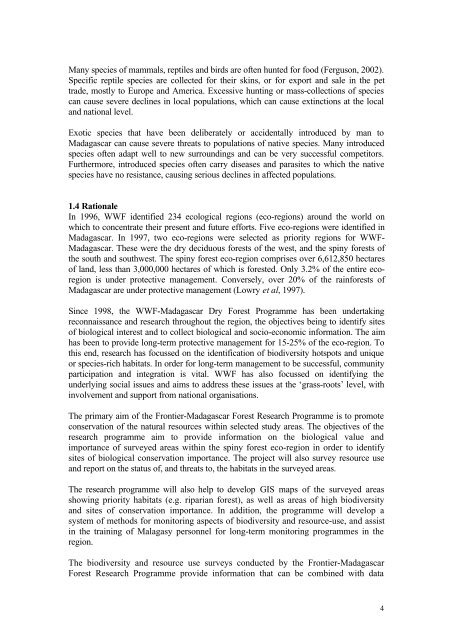The proposed Parc Regional de Belomotse - Frontier-publications ...
The proposed Parc Regional de Belomotse - Frontier-publications ...
The proposed Parc Regional de Belomotse - Frontier-publications ...
You also want an ePaper? Increase the reach of your titles
YUMPU automatically turns print PDFs into web optimized ePapers that Google loves.
Many species of mammals, reptiles and birds are often hunted for food (Ferguson, 2002).<br />
Specific reptile species are collected for their skins, or for export and sale in the pet<br />
tra<strong>de</strong>, mostly to Europe and America. Excessive hunting or mass-collections of species<br />
can cause severe <strong>de</strong>clines in local populations, which can cause extinctions at the local<br />
and national level.<br />
Exotic species that have been <strong>de</strong>liberately or acci<strong>de</strong>ntally introduced by man to<br />
Madagascar can cause severe threats to populations of native species. Many introduced<br />
species often adapt well to new surroundings and can be very successful competitors.<br />
Furthermore, introduced species often carry diseases and parasites to which the native<br />
species have no resistance, causing serious <strong>de</strong>clines in affected populations.<br />
1.4 Rationale<br />
In 1996, WWF i<strong>de</strong>ntified 234 ecological regions (eco-regions) around the world on<br />
which to concentrate their present and future efforts. Five eco-regions were i<strong>de</strong>ntified in<br />
Madagascar. In 1997, two eco-regions were selected as priority regions for WWF-<br />
Madagascar. <strong>The</strong>se were the dry <strong>de</strong>ciduous forests of the west, and the spiny forests of<br />
the south and southwest. <strong>The</strong> spiny forest eco-region comprises over 6,612,850 hectares<br />
of land, less than 3,000,000 hectares of which is forested. Only 3.2% of the entire ecoregion<br />
is un<strong>de</strong>r protective management. Conversely, over 20% of the rainforests of<br />
Madagascar are un<strong>de</strong>r protective management (Lowry et al, 1997).<br />
Since 1998, the WWF-Madagascar Dry Forest Programme has been un<strong>de</strong>rtaking<br />
reconnaissance and research throughout the region, the objectives being to i<strong>de</strong>ntify sites<br />
of biological interest and to collect biological and socio-economic information. <strong>The</strong> aim<br />
has been to provi<strong>de</strong> long-term protective management for 15-25% of the eco-region. To<br />
this end, research has focussed on the i<strong>de</strong>ntification of biodiversity hotspots and unique<br />
or species-rich habitats. In or<strong>de</strong>r for long-term management to be successful, community<br />
participation and integration is vital. WWF has also focussed on i<strong>de</strong>ntifying the<br />
un<strong>de</strong>rlying social issues and aims to address these issues at the ‘grass-roots’ level, with<br />
involvement and support from national organisations.<br />
<strong>The</strong> primary aim of the <strong>Frontier</strong>-Madagascar Forest Research Programme is to promote<br />
conservation of the natural resources within selected study areas. <strong>The</strong> objectives of the<br />
research programme aim to provi<strong>de</strong> information on the biological value and<br />
importance of surveyed areas within the spiny forest eco-region in or<strong>de</strong>r to i<strong>de</strong>ntify<br />
sites of biological conservation importance. <strong>The</strong> project will also survey resource use<br />
and report on the status of, and threats to, the habitats in the surveyed areas.<br />
<strong>The</strong> research programme will also help to <strong>de</strong>velop GIS maps of the surveyed areas<br />
showing priority habitats (e.g. riparian forest), as well as areas of high biodiversity<br />
and sites of conservation importance. In addition, the programme will <strong>de</strong>velop a<br />
system of methods for monitoring aspects of biodiversity and resource-use, and assist<br />
in the training of Malagasy personnel for long-term monitoring programmes in the<br />
region.<br />
<strong>The</strong> biodiversity and resource use surveys conducted by the <strong>Frontier</strong>-Madagascar<br />
Forest Research Programme provi<strong>de</strong> information that can be combined with data<br />
4
















